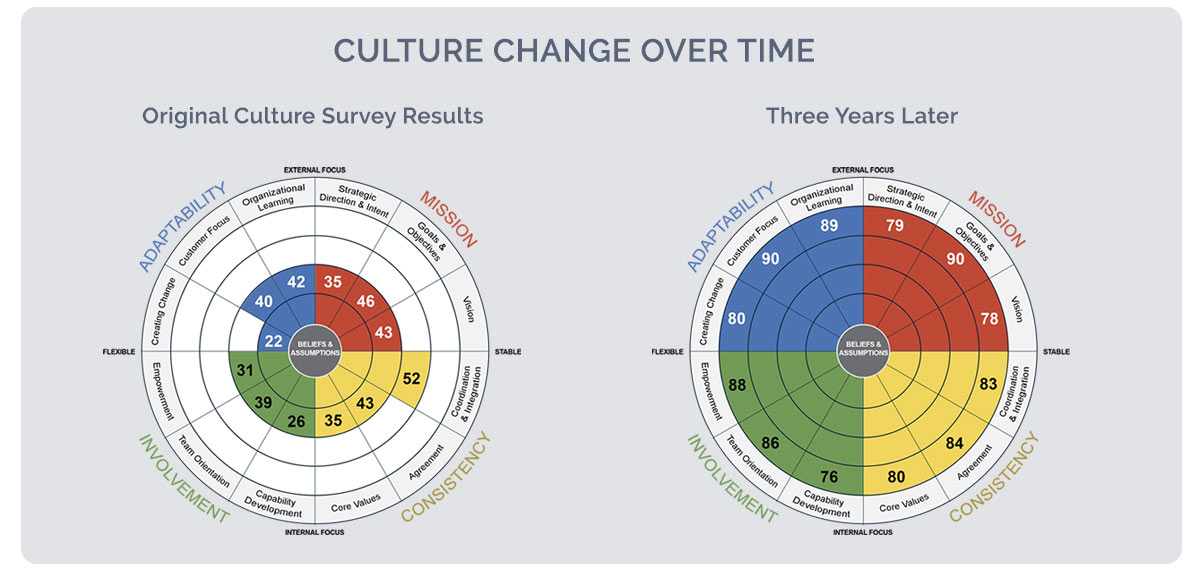
Culture Change: A Journey to Relevance at the DLA
How does a department move from “irrelevant” to “relevant”? How does it shift from being a department that employees want to be transferred out of to being the department that employees are asking to be transferred into?
This is the story of the Operations Support Group (OSG) at the Defense Logistics Agency’s Defense Supply Center, Columbus (DSCC), and some of the keys to their cultural transformation, a transformation that did not require thousands of dollars, but rather a new way of interacting and treating each other.
DLA’s Need: The Ability to Create Change and Customer Focus
When Sam Merritt began his tenure as the director of the Operations Support Group, he used his favorite way of learning about the department—he began walking around the office and simply asking, “How are you? What are you working on?” Initially, this created much anxiety among his direct reports. The manager of one division came out of his office one day, began suspiciously watching him, and eventually exclaimed, “What’s the problem? What’s wrong?!” Later, Merritt recalled, “I thought it was the funniest thing! I said, ‘Is it okay if I come out and talk to them without you staring over my shoulder?’” He also reassured the manager by saying, “Believe me, this isn’t about you.” After several months of engaging in this practice, people started to notice if Merritt hadn’t been around and would stop him to say, “Hey, I haven’t seen you in a while! How are you doing?”
Along with Merritt’s down-to-earth leadership style, other changes at OSG were developing out of their work with Denison. When they received their Denison Organizational Culture Survey (DOCS) results (see Original Culture Survey Results below), they decided they needed to be proactive and engage in an action planning process to turn their culture around.
They focused on two indices of the Denison Culture Model: Creating Change and Customer Focus.
“First, we needed to make sure our associates knew we were serious about implementing their ideas and suggestions,” Merritt said. “We needed to make sure they knew we were listening. Then we needed to make sure that everybody was clear on who our customers are and how to respond to their feedback. Our challenge was to commit to implementing the feedback and monitoring our progress because it is easy to put this aside with the everyday battle rhythm of our normal work.”
As part of the action planning process, OSG convened a seven-member Culture Council. They developed a council charter that stated Culture Council members would be volunteers only—there would be no forced participation—and that they would not include managers. They set the standard that people would only serve on the Council if they were really interested in changing the culture of OSG. “The idea we sold was, ‘This is your opportunity to create the environment you want to work in,’” says Merritt.
“The idea we sold was, ‘This is your opportunity to create the environment you want to work in.’”
– Sam Merritt, Director, OSG
Solution in Action
Initially the Culture Council met weekly to form the action plan. Once they reached the implementation phase, they met twice monthly, once with Merritt and once with the subdivision chiefs. As Culture Council member Lou Jaquish said, “We were motivated to create the environment we wanted to work in.”
So how did OSG go from index scores in the 30th percentile to scores the 80th percentile in three years? Sam Merritt, the Culture Council, and OSG changed their culture through specific, often small actions that improved the quality and quantity of communication, directed their focus on their customers, and simultaneously increased the meaningfulness of their work.
Improving Communication
In order to improve the honesty and frequency of communication in the department, the Culture Council and Merritt devised numerous initiatives.
First, the Culture Council came up with the idea of having an Ombudsman to be an honest broker of employee’s issues and concerns.
The Ombudsman’s charge was to hear and address the concerns of the 250 member department, acting as a mediator to resolve disputes and provide advice on sensitive issues that employees didn’t feel they could take to their managers or to others in the organization.
Second, to improve the communication within the department, Merritt began releasing the minutes of the regular meetings of the division heads of OSG. Merritt encouraged the heads of each division to have regular meetings with their staff and to circulate the minutes of those meetings. This created an open environment where people felt they knew what was happening in the organization and consequently no longer “filled in the blanks” with potential misconceptions.

The OSG made extraordinary progress in a short span of time, increasing their Denison scores by up to 58 percentile points. Increases can be seen in each of the four quadrants, balancing out key areas.
“You have to be brutally honest . . . If you are not going to tell the truth about what you think, don’t expect things to improve.”
– Sam Merritt, Director, OSG
Finally, the Culture Council worked hard to create an environment of openness and honesty, encouraging employees to say what’s on their minds. As one member of the Culture Council said, “If you are willing to say it, we are willing to address it.” The Culture Council worked to address employee’s concerns and respond to the ideas put forth as well as create a safe environment for people to discuss the issues that concern them. As a result, “We’ve created a culture here where it’s pretty safe for people to say what they want to say,” says Merritt. The other side of this, however, is that managers also got the “raw truth” and had to develop their skills to respond constructively. Employees in OSG became more forthcoming to say what they think. While there have been major improvements in OSG’s culture profile, this doesn’t mean people are simply happier; their initiatives to improve communication increased the number of challenges they face (good and bad) on their journey to become a high performance organization. Merritt explains, “You have to be brutally honest…if you are not going to tell the truth about what you think, don’t expect things to improve.” With this new openness to communication, OSG is now facing its challenges head on and delivering results.
Improving Customer Focus
After taking on their communication challenges and making progress in the Creating Change index, the next challenge for the division heads was to improve their Customer Focus index. Several divisions of OSG created customer satisfaction surveys to see if they were meeting the needs of their “customers.” Some of the divisions’ surveys went to external customers, others went to internal customers. They wanted to communicate to employees in the larger organization that OSG hears their voice and is working to act on to their needs. The process of creating and deploying the surveys themselves was a valuable experience. It allowed employees to meet with many of the customers they had lost direct contact with through the anonymity of their work processes.
In one case, the Document Standardization Division conducted surveys over a six month period, soliciting feedback from over 400 external customers. The feedback revealed that, while Division personnel routinely provided high levels of customer support, customers felt changes to the Division’s website were needed. One customer explained that finding the right contact via the website was a challenge. The feedback resulted in the entire website being updated to provide contact information for each area on the main search pages as well as on the standard pages. Another customer said it would be helpful if the general listing documents were updated more often. As a result, the listing documents are now updated on a regular basis and checked to ensure their status is current.
A second initiative helped OSG improve its internal customer focus. Orientation sessions about OSG’s operations were developed for onboarding incoming employees from outside their department. This enabled new employees to understand the ways that OSG can support them in the future. This training was developed from a suggestion by an OSG associate who wanted to know more about the other Divisions in OSG. This overview training has become mandatory for new associates and is conducted within the first or second month of employment or transfer into the organization. Responses to the questionnaire given after each training session indicate that OSG has successfully established an overview of their mission. As a result of OSG’s success in onboarding, all incoming employees and DSCC interns now receive the same overview training.
Outcomes: Making Tasks Meaningful
Merritt also helped improve the purposefulness of OSG staff’s day-to-day work by linking their tasks to the mission of the organization. As he says, “At the end of the day, the war fighter is the reason you are here…You may be printing copies or you may be scanning, but that is a piece of the big picture.” To help members of OSG recognize the larger meaning of their work, Merritt approved a service member coming in to talk about serving in Iraq and how they appreciate what the Defense Logistics Agency has done. This brought home the point that having the right item and data systems is critical. Having the wrong data may delay procurement and slow down the delivery of essential items to service members in Iraq, Afghanistan and elsewhere.
In most cases these initiatives did not cost a great deal. They were more about building trust, respect, and a genuine concern for others. For example, Merritt realized that management only sent letters to employees with a death of a father/mother or son/daughter.
Merritt asked why letters are sent only after a loss? Why not for joyous occasions as well? Merritt expanded his letter writing to include any significant event that he is aware of, especially when an employee has a new son or daughter. It is a small gesture, but hundreds of these gestures throughout the department have added up and have helped to change their culture, improve the quality of communication, increase their understanding of who they serve, and increase the purposefulness of their work.
Culture change efforts at OSG are ongoing. The Culture Council continues to work on the Creating Change index and is developing a Peer Award program. Merritt comments, “You can’t afford not to have a positive culture.” The results they have achieved—increased employee retention, improved customer service, and better war fighter support—prove this daily.
